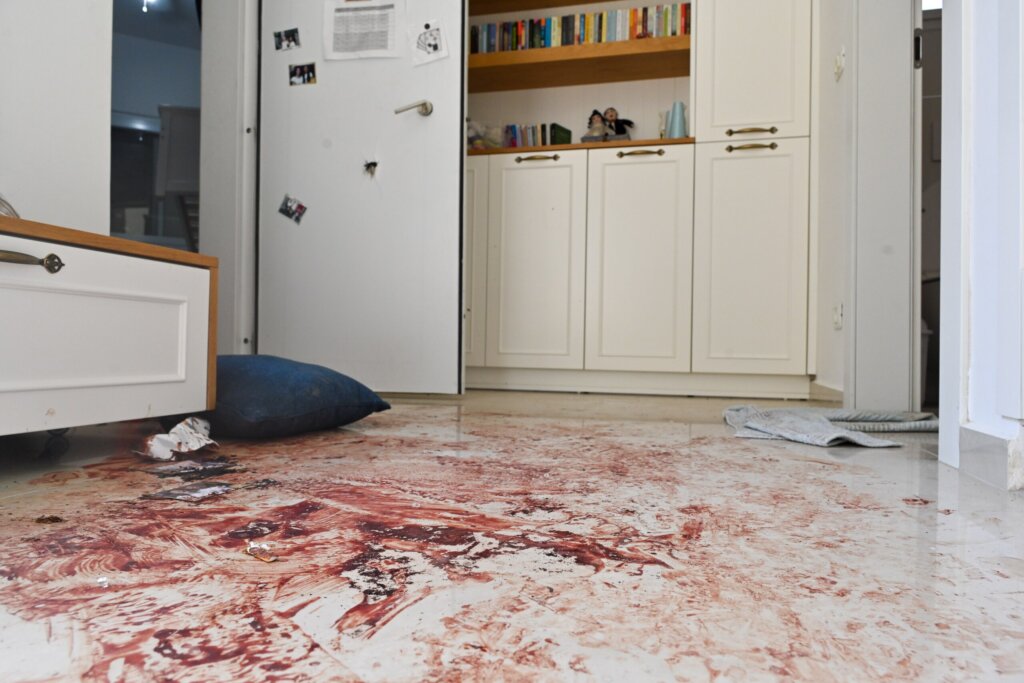
Israeli forces massing on the Gaza border have apparently taken a lesson from the war in Ukraine, installing anti-drone cages atop their tanks as they prepared for an anticipated assault on Hamas fighters taking refuge in the Palestinian territory.
The so-called “cope cages”—sheets of improvised armour mainly designed to protect troops against bombs dropped from hovering unmanned aerial vehicles, or drones—were evidently installed after Hamas launched a sweeping surprise attack on Israeli soft targets, including almost a dozen kibbutzim and a music festival.
“My assumption is that the Hamas attacks gave Israel the impetus to install the cages more widely,” Mark Cancian, a senior adviser with the D.C.-based Center for Strategic and International Studies, told The Washington Post.
“It was probably something they had been thinking about before since everyone is watching the war in Ukraine closely.”
The United Nations Office for the Coordination of Humanitarian Affairs says some 1,400 people have been reported killed in the Hamas attack and since—more than triple “the cumulative number” of Israelis killed in the ongoing conflict since it began recording casualties in 2005. Six Canadians and 31 Americans were known to be among the dead. Israeli authorities say least 212 people were taken hostage.
Israel has since launched multiple missile strikes on the 365-square-kilometre coastal territory at its southwest corner, home to more than 2.3 million Palestinians. On Oct. 23, the UN reported the number of Gaza residents killed since the Hamas raid at 5,087, more than 62 per cent of whom were women and children. It said at least 15,273 Gaza residents had been injured.
All the numbers came from official sources in Israel and Gaza respectively and have not been independently verified.

“The problem for the Israelis, however, is that the Merkava’s new cage is a modest one.”
Quadcopters and first-person-view (FPV) racing drones operated by “pilots” working some distance from their targets have played an unprecedented role in the Russia-Ukraine war, now approaching its third year since Vladimir Putin’s forces launched what the Russian president at the time called a brief “special operation.”
The term “cope cages” was popularized when photo and video of improvised defensive screens started appearing on Russian tanks in the war’s early days. Vice reports the technique was first used in 2020 during the Nagorno-Karabakh conflict between Armenia and Azerbaijan. It was initially meant as a pejorative, but multiple militaries have since adopted the improvised armour.
Explosives-laden drones pose a growing threat to tanks and other armoured vehicles. Relatively cheap, off-the-shelf grenade-dropping quadcopters and the self-exploding racing, or suicide, drones have knocked out hundreds of multimillion-dollar tanks on both sides of the Ukraine war.
Now, Hamas is deploying them against Israel. During its Oct. 7 attack, Hamas struck Israeli outposts along the 65-kilometre border wall separating the Jewish state from the Gaza Strip. Quadcopters dropped improvised explosives on four communication towers along the border and hit tanks, too.
Seventy-tonne Merkava tanks, with four Israeli crew, routinely patrol the border using precise optics and 120-millimetre main guns. Hamas struck several with grenade-dropping drones, their videos depicting at least two successful strikes on what were reportedly mainstay Merkava Mark IVs. Both burned.
#BREAKING Hamas armed drone strike on Israeli Merkava 4 tank. pic.twitter.com/e8gph7tYVK
— Clash Report (@clashreport) October 7, 2023
With the Merkava and other vehicles, it’s largely a case of simple, more primitive technology outperforming sophisticated new systems.
A cope cage is designed primarily to deflect drone-dropped grenades or an explode-on-impact racing drone before it hits its target.
“The problem for the Israelis, however, is that the Merkava’s new cage is a modest one: it only covers a Merkava’s turret, and leaves exposed the front of the hull and the turret bustles,” reported David Axe for Forbes.
“The front of the hull is where the engine is. The bustles, which hang off the back of the turret, contain spare ammunition for the main gun. Both the engine and the bustles are weak spots in the Merkava’s design. It’s not for no reason that, when Hamas prepared a handbook on the Merkava’s vulnerabilities, it highlighted the bustles and the engine compartment, albeit the sides of the engine compartment.”
The Merkava has relatively thick armour on its turret roof, a lesson the IDF painfully learned during past encounters with Arab anti-tank missiles. Axe predicts future iterations of Israeli cope cages will cover the whole vehicle.
With the Merkava and other vehicles, it’s largely a case of simple, more primitive technology outperforming sophisticated new systems designed to defend against more advanced weapons.
The Merkava’s Trophy defence system tracks incoming rocket and missile attacks, then fires a small spread of explosive projectiles to intercept the munition and detonate it before it hits the tank.
“Using them against approaching drones…would need at least software and configuration changes—assuming that is doable without exceeding the number of false detections, which would result in Trophy wasting its limited ammo,” Jakub Janovský, an open-source intelligence analyst, told Vice.
Older tanks such as the T-80s and T-64s that Russia has deployed in Ukraine have inferior armour and are especially vulnerable to airborne attack. Weapons like the shoulder-fired Javelin missile have made quick work of some Russian armour.

Hamas uses the Gaza Strip as a base for operations targeting Israel. The Canadian government declared it a terrorist organization in 2002 and upheld the designation after a 2021 review. The larger of the two Palestinian territories, the West Bank, is controlled by its secular rival, Fatah.
With rockets, drones and over 2,000 troops – This is how Hamas launched the attack on Israel, step by step@itamarmeiri78 | #KanIsraelstory pic.twitter.com/5ocxeVgIrv
— כאן חדשות (@kann_news) October 15, 2023

Advertisement










